Altan T. Metal Forming Handbook
Подождите немного. Документ загружается.


tation. As this would render the lubricant unusable, bactericides are
generally added to the lubricants by most suppliers. The lubricant
quantities are set using simple manual control devices. Automatic
devices for controlling the lubricant quantity are available. Where
lubricants contain graphite, an agitating device in the reservoir is essen-
tial in order to prevent solid graphite particles from settling down in
the reservoir.
Spray systems with compressed air as carrier
Mist coolant application systems provide an extremely fine surface film
of coolant and lubricant for optimum cooling and lubrication. Coolants
and lubricants are fed using a joint pipe. Water is used for cooling, while
depending on the process involved, different lubricating agents can be
used. Graphite-free emulsions containing water-mixable oils are gener-
ally used for simple forming operations. Where more complex forming
processes have to be performed (such as constant velocity joint compo-
nents used in vehicle drive systems), emulsions made of oil and graphite
are used. These emulsions comprise a 1 : 1.3 to 1 : 4 mixture with water.
The water and lubricant quantities are controlled alternatively by elec-
tro-valves. Compressed air is used as a carrier medium for the lubricant.
Compressed air and water or lubricant are mixed to create a mist in a
mixing valve and fed to the die through a joint pipe. The electro-valves
are controlled individually for each station.
Cooling systems for forging
During automatic forging, high-pressure spray systems (80–120 bar) are
used for cooling purposes. There is generally no need for additional
lubrication. In order to achieve the necessary degree of heat dissipation,
considerable quantities of water are required (between 40 and 60 m
3
/h).
The cooling water is cleaned, recooled and then re-used. The scale col-
lected in the water must be removed using screens and filters.
Billet heating
Billets are heated by induction. For the temperature range of 760 to
800 °C, inductor outputs of approx. 0.24 kW are required per kg of steel.
Depending on the billet diameter, the frequency range lies between 2
and 4 kHz. For forging temperatures from 950 to 1,100 °C, around 0.40
to 0.45 kW/kg of steel are required at frequencies of 1 to 2 kHz. In gen-
521
Presses used for solid forming
Metal Forming Handbook / Schuler (c) Springer-Verlag Berlin Heidelberg 1998

eral, aluminium and aluminium alloys are also heated by induction to
temperatures between 420 and 480 °C, depending on the alloy. The
required inductor output is approx. 0.35 to 0.4 kW/kg with a frequency
of 0.5 to 1 kHz.
Thyristor-controlled systems are used as converters. Considerable
quantities of cooling water are required to cool the inductors. Recool-
ing is performed in the plant’s own recooling systems or in separate
installations.
Billet preparation
Warm forming (680 to 800 °C) of shaft-shaped parts made of steel fre-
quently calls for coating (pre-graphitizing) of blanks. This measure
serves to increase die service life and is particularly beneficial for first
pressing operations (generally forward extrusion or reducing operations).
The graphite can either be tumbled on prior to heating, or sprayed on
during the heating process. This entails inductive pre-heating of the
blanks (approx. 180 °C), followed by spray application of the graphite-
water mixture. The water evaporates over a relatively short travel, during
transport to the main induction heater. Thus, the billets are heated with
a dried-on coating of graphite. Although a proportion of the applied
graphite burns, a relatively high percentage (approx. 60 %) still permits
lubrication and, together with a (very thin) scale layer, creates the
desired lubricating and separating effect in the die.
6.8.6 Sizing and coining presses
Sizing of forged and sintered parts
The dimensions, tolerances and surface quality of forged or hot formed
parts frequently fail to meet the standards expected from finished prod-
ucts. Consequently, often costly finish processing operations are neces-
sary. By introducing a sizing operation, substantially narrower toler-
ances can be achieved and subsequent machining processes can be
reduced.
Many forged parts are finish machined on machining centers. These
call for precise clamping and contact surfaces in order to assure a repro-
ducible and well defined workpiece clamping. It is frequently not pos-
sible to achieve, in forged parts, a surface quality that is required for
522
Solid forming (Forging)
Metal Forming Handbook / Schuler (c) Springer-Verlag Berlin Heidelberg 1998
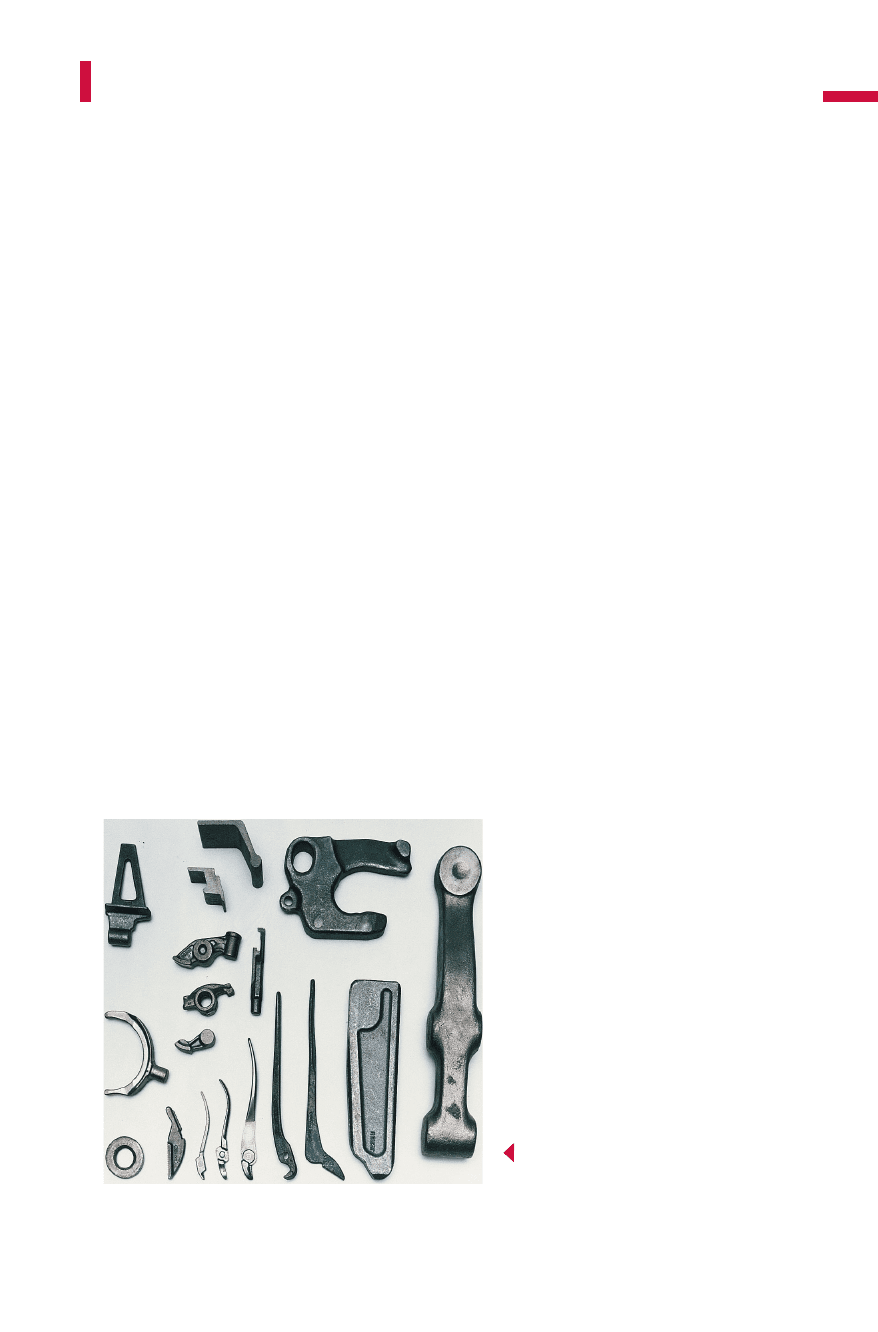
adequate clamping. In this case, cold sizing of the appropriate surfaces is
an essential pre-requisite for successful further processing (Fig.6.8.13).
Sintered parts are also frequently subjected to a subsequent compacting
or sizing process in order to compensate for warping caused by heat
treatment (Fig.6.8.14).All these operations require a large forming
force, coupled with minimal machine and die deflection. Due to its
favorable force distribution, the knuckle-joint bottom drive press has
been shown to offer the most suitable forming system for coining appli-
cations. The basic principle of this drive type is described in Sect. 3.2.2
and 6.8.2 (cf.Fig.3.2.5).
Compared to presses for solid forming, the slide stroke and work
length can be substantially shorter. Sizing is generally performed in a
single station, so allowing the die mounting area or the press bed to be
smaller. Ejector systems in the slide and press bed are only necessary for
coining work.
Cutlery embossing presses
In addition to possible applications already outlined here, this type of
sizing press is also used with a good degree of success for the forming
and embossing of cutlery. This operation allows even the finest chis-
elling effects to be precisely embossed.
523
Presses used for solid forming
Fig. 6.8.13
Coined forgings
Metal Forming Handbook / Schuler (c) Springer-Verlag Berlin Heidelberg 1998

524
Solid forming (Forging)
Fig. 6.8.14 Coined sintered parts
Fig. 6.8.15 Operating sequence for the manufacture of open wrenches
Metal Forming Handbook / Schuler (c) Springer-Verlag Berlin Heidelberg 1998
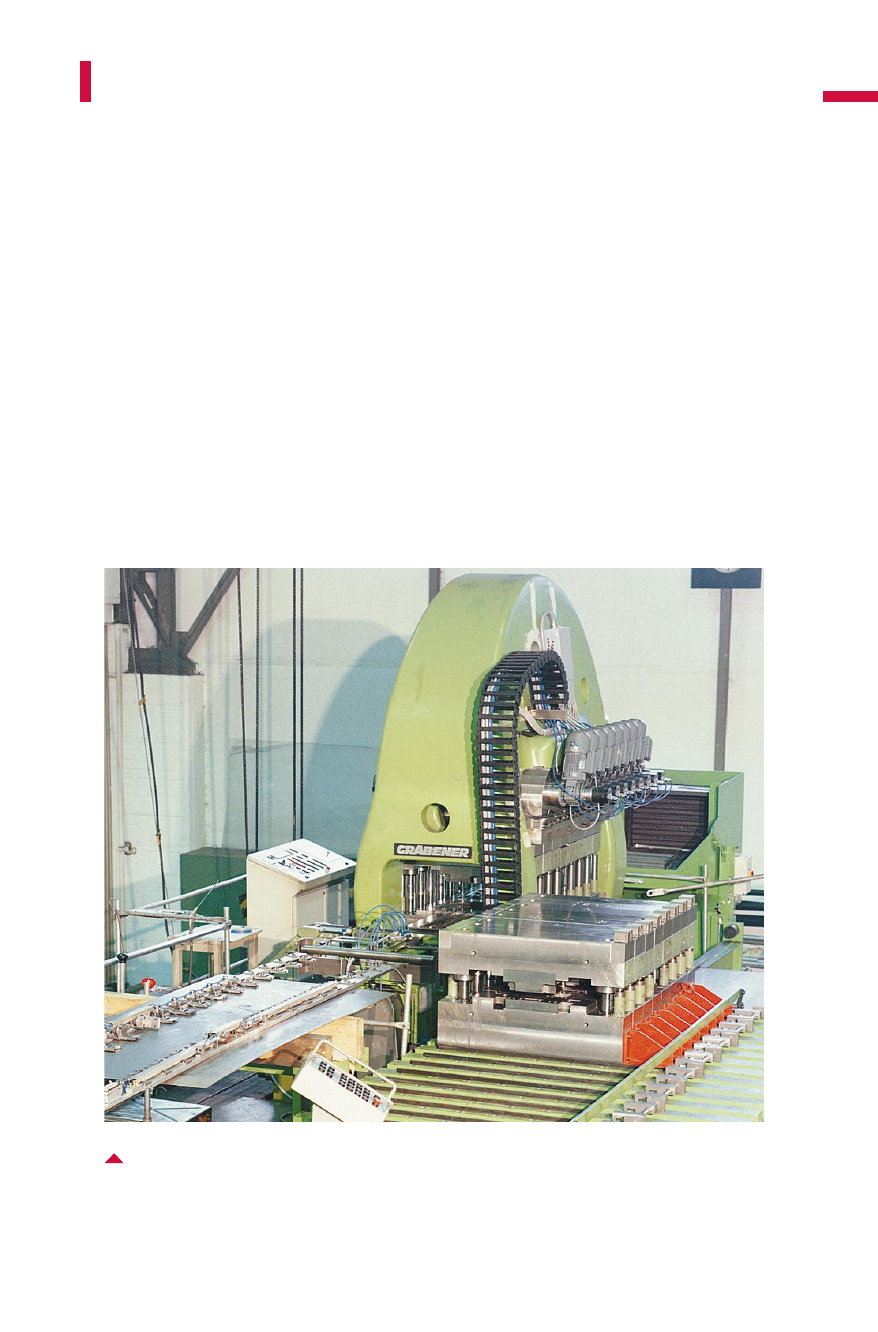
Embossing of hand tools
Another field of application for calibrating presses is the embossing of
hand tools. Figure 6.8.15illustrates the sequence of operations involved
in the manufacture of an open wrench. Using slugs blanked from plate,
the parts are manufactured in eight operations on a knuckle-joint press
with bottom drive, nominal press force 16,000 kN (cf.Fig.3.2.5).The
production stroking rate is 35 parts per minute. The plant operates on a
fully automatic basis. The slugs are stored, and a two-axis transfer is
used as a feed system (Fig. 6.8.11). In order to assure fast die change, die
change sets are used. These can be moved in and out, controlled by
pushbutton, by a die change cart (Fig. 6.8.16).The die sets are fastened
by means of hydraulic clamps (cf. Fig. 6.7.1).
525
Presses used for solid forming
Fig. 6.8.16 Line for the manufacture of open wrenches
(nominal press force 16,000 kN, transfer feed and die change cart)
Metal Forming Handbook / Schuler (c) Springer-Verlag Berlin Heidelberg 1998

6.8.7Minting and coin blanking lines
Rimming and edge lettering machines
Coin blanks are manufactured on high-speed blanking presses from an
indexed sheet metal strip (cf. Fig.4.6.6and 4.6.8).Depending on the
material characteristics and the condition of the die, a rough cut surface
and/or blanking burr are formed at the outside surface of the coin blank
(cf.Fig. 4.7.8).To achieve a high level of coin quality, the outside edge
of the coin blank must be smoothed. This is achieved by a radial upset-
ting process in rimming and edge lettering machines.
When smoothing the edge, the coin blank is sized within extremely
narrow tolerance limits (+/– 0.02 mm). Reducing the diameter by 0.2 to
0.5mm causes material to accumulate at the periphery of the coin
blank. Depending on the intended purpose, different upsetting shapes
can be selected (Fig. 6.8.17).The rimming or upsetting process helps to
accumulate the material necessary for forming the rim area of a coin.
Thus, this material does not have to be forced outwards from the center
of the coin blank. As a result, the coining process, conducted after upset-
ting, requires less force. Reduction of the coining force leads in turn to
an increase in the service life of the coining dies.
Rimming machines are used for a diameter range from 14 to 50 mm
both with vertically and horizontally arranged upsetting shafts. In rim-
ming machines with a vertical upsetting shaft, the blanks are fed
towards the upset die, which comprises the upset ring and upset seg-
526
Solid forming (Forging)
Fig. 6.8.17 Upsetting shapes on coin blanks
t=upsetthickness
unprocessedblank shape R :highlyrounded
shape
P :slightlyrounded
shape
M :flatknurling shape S :flatknurling
s=blankedthickness
D
0
D
1
D>D
01
Metal Forming Handbook / Schuler (c) Springer-Verlag Berlin Heidelberg 1998
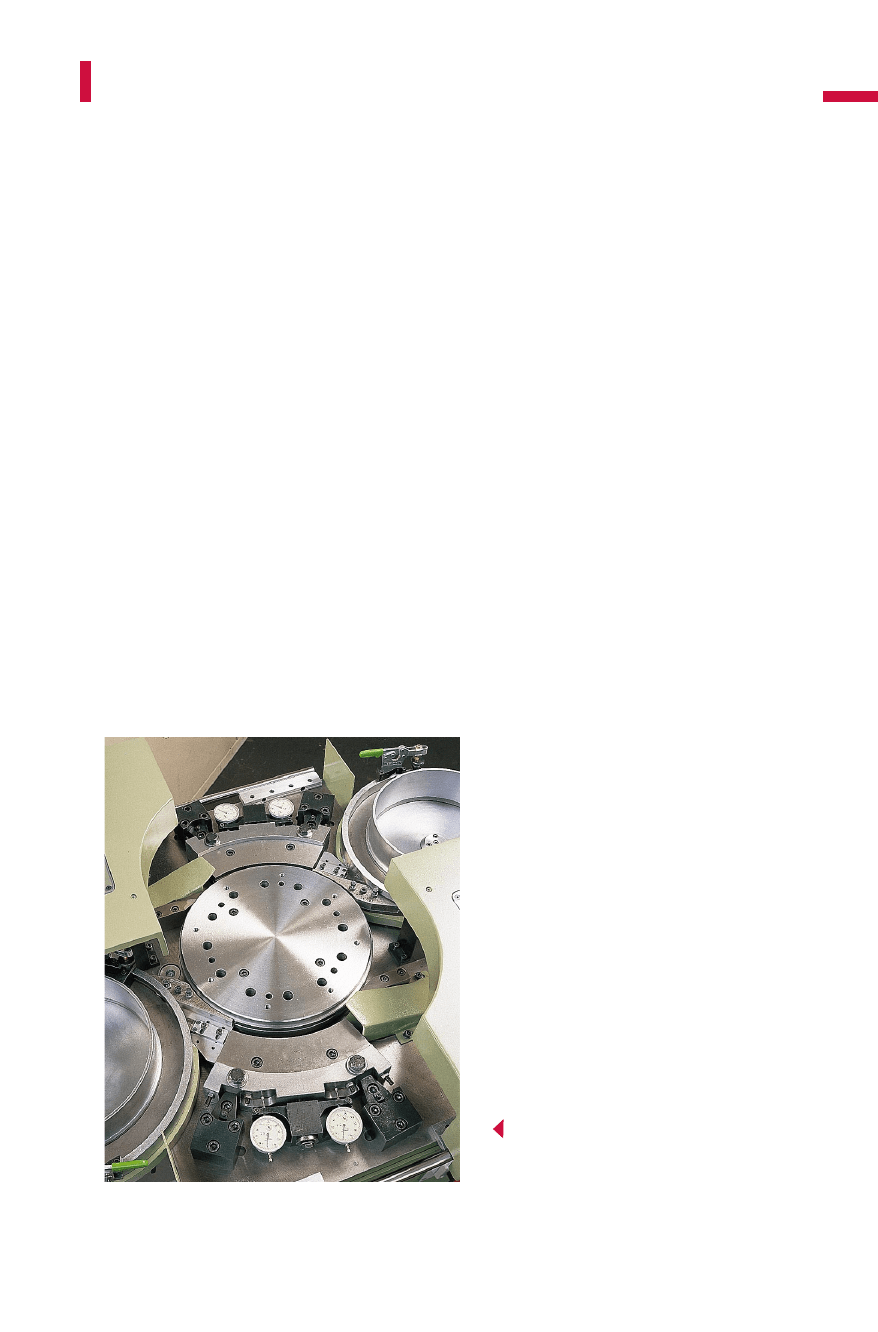
ment, by means of two diametrically arranged mechanical hoppers and
channels(Fig.6.8.18).During the rolling process between the upset ring
and upset segment, diameter reduction takes place. Rimming machines
with horizontally arranged upsetting shaft can be used both for rim-
ming or upsetting, and also for embossing deep-set edge lettering and
decoration of coin blanks. Edge lettering is carried out around the
periphery of the coin blank in a separate work cycle in which the previ-
ously upset blank is rolled and deep-set between the upset ring and the
lettering jaws.
Depending on the machine type and the diameter of the coin blank,
rimming machines achieve an output of 130,000 and 600,000 pcs/hour.
Minting presses
For minting applications (change coins with a diameter of between 14
and 40mm) preferably presses with knuckle-joint drive or with modi-
fied knuckle-joint drive system are used (cf.Sect.3.2) with nominal
press forces from 1,000 to 2,000 kN and stroking rates between 650 and
850/min (Fig. 6.8.19).
527
Presses used for solid forming
Fig. 6.8.18
High-performance rimming
(upsetting) machine
Metal Forming Handbook / Schuler (c) Springer-Verlag Berlin Heidelberg 1998
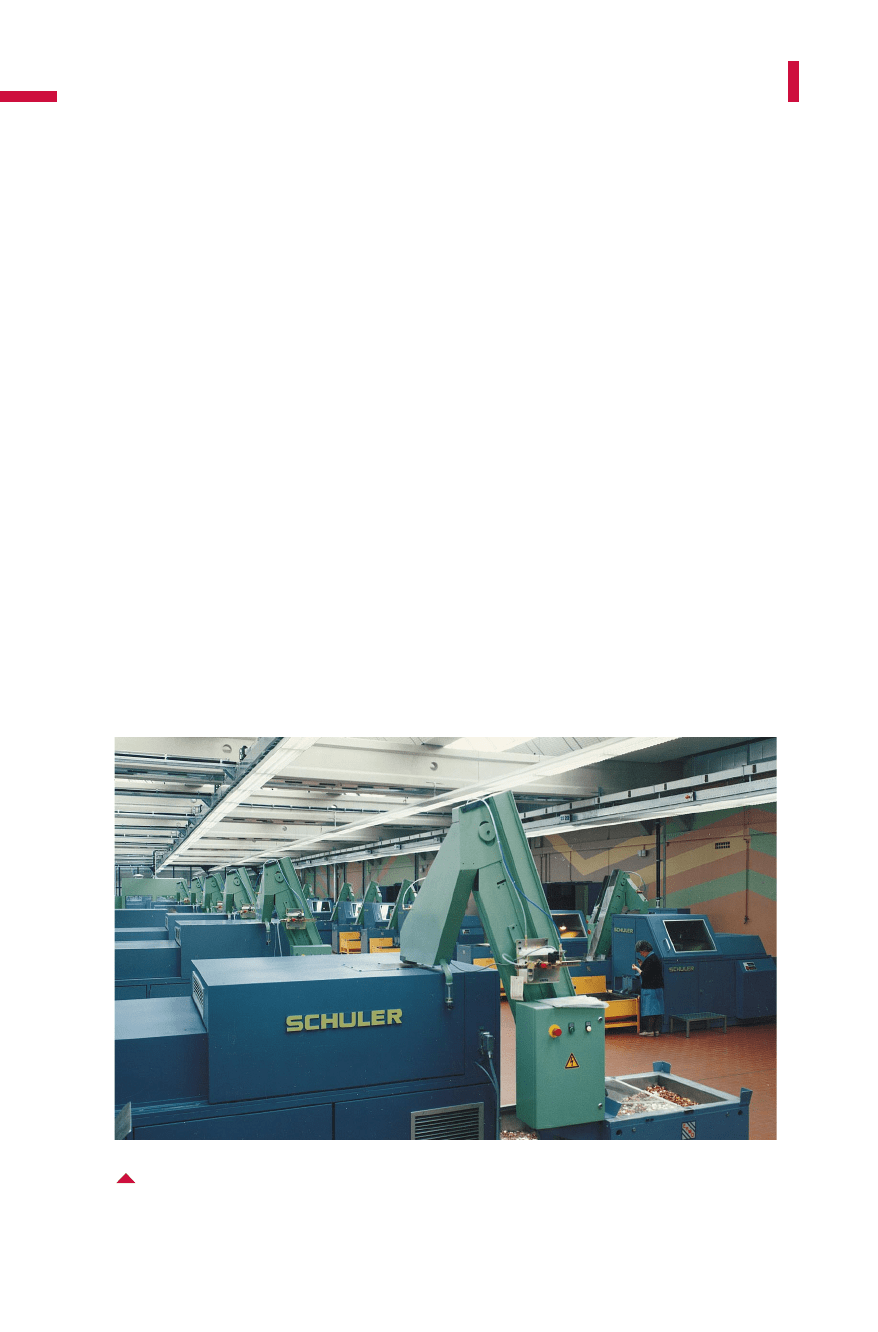
Minting presses are designed in a vertical and also horizontal version.
Horizontally working presses are used to produce round coins. This
machine design is characterized by simple operation and a low number
of coin-specific exchange parts (Fig. 6.8.20).Vertically operating presses
can be universally applied for the production of round, multiple-edged
and bimetal coins (Fig. 6.8.21);however, a greater number of coin-spe-
cific exchange parts is required here.
The monobloc press frame made of nodular cast iron offers good
damping properties (cf. Fig.3.1.1).The press is driven by means of a
controllable electric motor, flywheel, eccentric shaft and knuckle-joint.
The bearing points in the knuckle-joint (friction bearing) are config-
ured for a maximum specific compression stress of 110 N/mm
2
. The
slide is mounted without backlash in pre-tensioned roller gibs. The
indexed dial feed plate for infeed and outfeed transport of the coin
blanks and coins is driven by means of a synchronous timing belt from
the eccentric shaft. The coin blanks are fed by means of mechanical
hoppers and channels towards the indexed dial feed plate. The ejector
system is directly linked to the slide and safeguarded against overload-
ing. The coining dies can be exchanged (coining punch and minting
528
Solid forming (Forging)
Fig. 6.8.19 Press shop of a modern mint
Metal Forming Handbook / Schuler (c) Springer-Verlag Berlin Heidelberg 1998
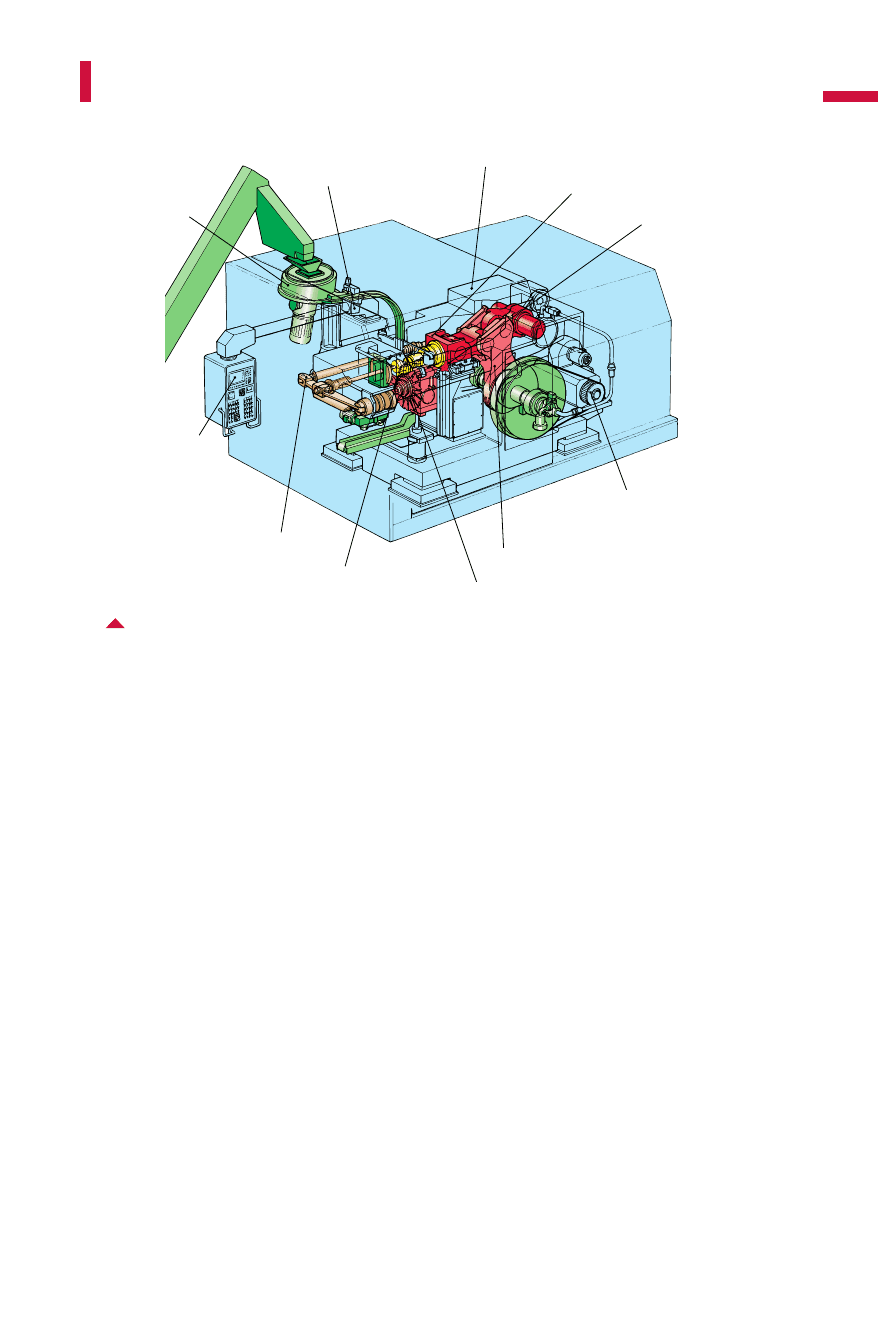
collar) within 2 to 3 min. The machine rests on vibration absorbing ele-
ments. As a result, no more than 10 % of the static load is transmitted
into the foundation as dynamic loading. This means that the presses can
be set up on upper floors. These presses are generally equipped with
sound enclosures in order to minimize noise generation.
The coin blanks are fed towards a mechanical hopper via an inclined
conveyer with storage space or other metering systems (Fig.6.8.22). The
hopper operates according to the centrifugal principle, which ensures
particularly gentle handling of the blanks. The possibility of scouring is
minimal, and noise development is also accordingly low.
The hoppers have a slight incline. The feed plate is directly driven by
an adjustable gear motor. The outfeed channel is tangentially located.
Depending on the diameter of the blanks, this arrangement permits
feed rates of up to 3,000 blanks/min.
When resetting for the production of different coin sizes, only the
blank outfeed channel and thickness need to be adjusted. No exchange
parts are required. Depending on the press design, the hopper and feed
529
Presses used for solid forming
Fig. 6.8.20 Horizontal minting press
monobloc press frame
punch holder
slide
link drive system
main drive
dial feed plate
feed hopper
blank control and
discharge device
punch holder
electronic
press
control
ejector
Metal Forming Handbook / Schuler (c) Springer-Verlag Berlin Heidelberg 1998
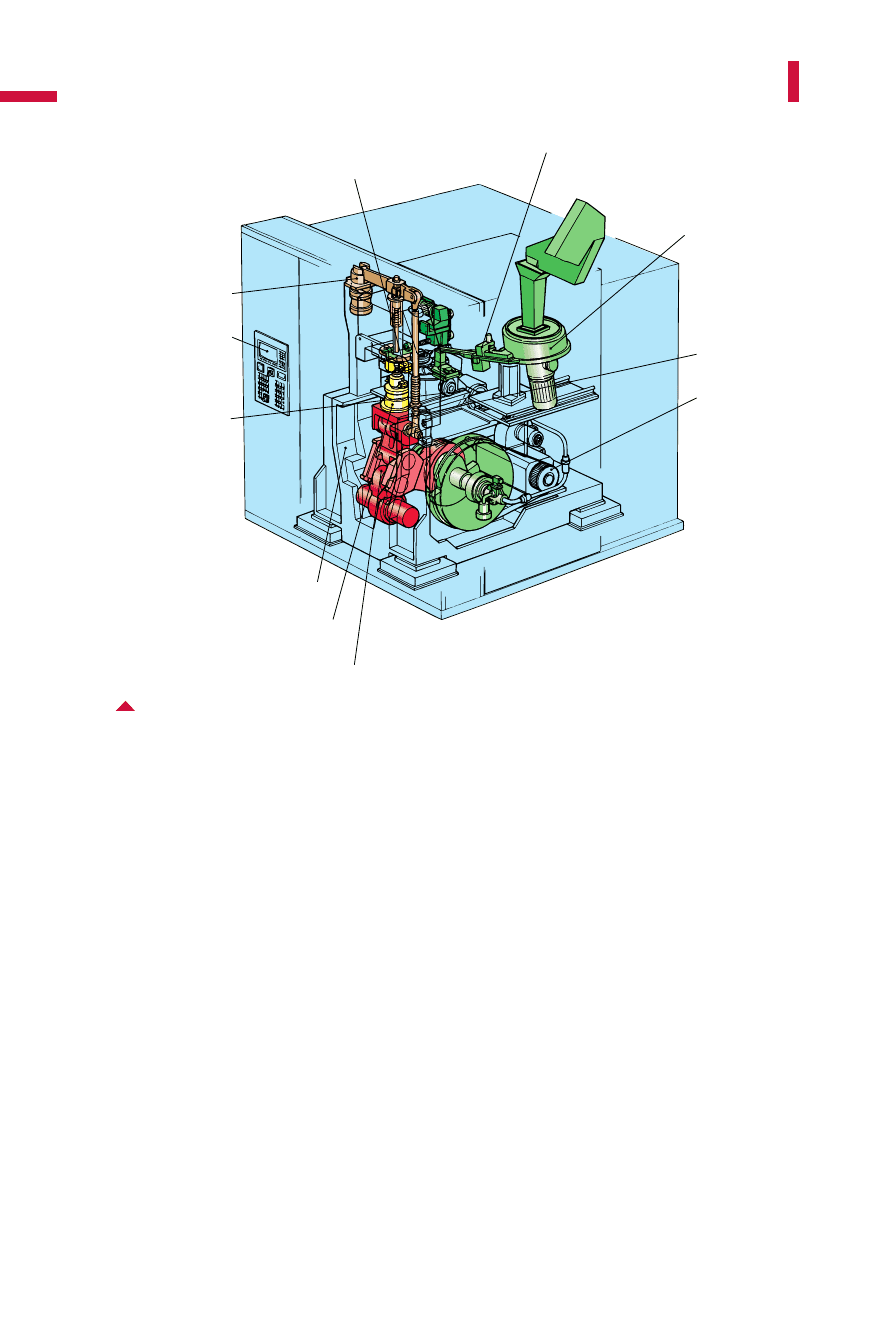
channel can be swivelled out or moved completely out of the press for
die change.
In the following channel, the blanks are checked for diameter and
thickness related defects, and ejected if found to be outside the permissi-
ble tolerance (Fig.6.8.23).The standstill periods caused by off-size blanks
would seriously impair the efficiency of high-speed machines. Therefore,
coin blanks with defects are automatically segregated in a control station
while the machine is running. If a defective blank reaches the control sta-
tion, the flow of blanks is interrupted. The interruption triggers a sensor,
which disables further blank feed from the hopper by means of a stop
cylinder. The gauge jaws are opened by means of a lift cylinder and the
off-size blank is ejected into a collecting tray. The gauge jaws return to
their home position, the stop cylinder opens and blank feed continues.
The described cycle takes only fractions of a second, ensuring a continu-
ous supply of blanks and preventing production disruptions.
530
Solid forming (Forging)
Fig. 6.8.21 Vertical minting press
ejector
electronic press
control system
punch holder
dial feed plate
punch holder
monobloc press frame
link drive system
blank control and
discharge device
feed hopper
slide
main drive
Metal Forming Handbook / Schuler (c) Springer-Verlag Berlin Heidelberg 1998
